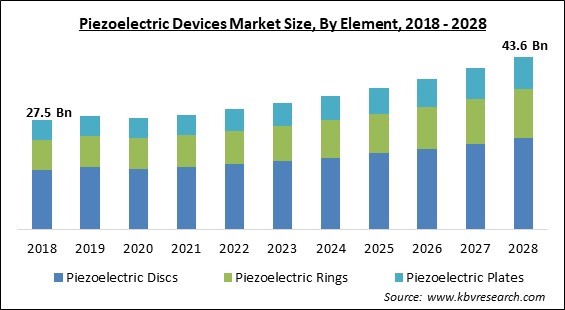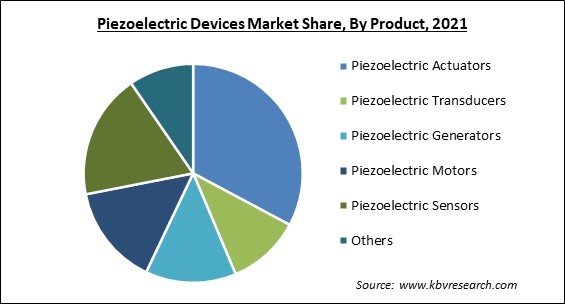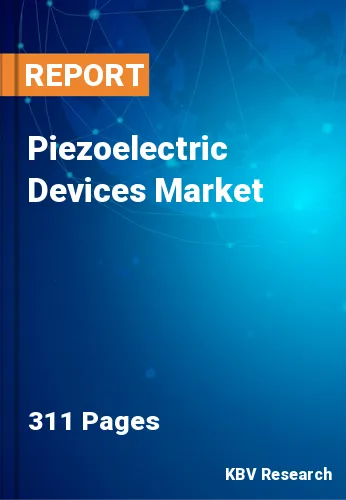The Global Piezoelectric Devices Market size is expected to reach $43.6 billion by 2028, rising at a market growth of 6.2% CAGR during the forecast period.
A piezoelectric device is one of the systems that employ the piezoelectric effect to compute acceleration, pressure, temperature, strain, or force changes by converting them to an electric charge. These piezoelectric devices are used for quality management, process control, and research & development in numerous industries, including the aerospace, and medical sectors.

Piezoceramics is the fundamental component of piezoelectrical devices, which are utilized in the automotive industry to regulate combustion in internal combustion engines. Piezoelectricity is a property shown by some materials in which, when a force is applied, the material creates an electric field. In contrast, when an electric field is applied throughout the material, its dimensions undergo deformation. These materials turn mechanical energy into electrical energy and vice versa.
Due to this characteristic, they are frequently known as transducers. These materials employ piezoelectricity to assess changes in velocity, stress, strain, or force by turning the energy difference into an electrical charge. On the basis of this effect, these materials are utilized in sound and frequency production and detection, ignition devices, SONAR, as well as pressure and displacement measuring systems.
The piezoelectric effect is widespread in nature and in several manufactured materials. Piezoelectric materials are able to convert strain and vibrational energy into electrical energy. This characteristic enables the implementation of renewable and sustainable energy in buildings through power harvesting and self-sufficient smart sensing. As the most prevalent building material, ordinary cement paste lacks adequate piezoelectricity and is ineffective at collecting electrical energy from a building system's ambient vibrations.
The COVID-19 outbreak has had a significant impact on the piezoelectric devices market. The stagnation of new projects all over the world has resulted in a decline in the demand for analog semiconductors. As a result of workers staying at home, it has been challenging for manufacturers to incorporate new piezoelectric devices, which has disrupted supply chains throughout the world. Moreover, governments in various counties were compelled to impose lockdowns throughout their nations in order to stop the spread of the infection, which led to an industrial closure. Owing to this, manufacturing facilities all over the world were temporarily shut down. Therefore, the demand for piezoelectric devices also reduced significantly throughout the manufacturing industry.
Energy harvesting is the technique of gathering and transforming environmental heat, wind, light, and mechanical energy into electrical energy. This energy is easily transported, can be directly provided to equipment or devices, and can be accumulated in batteries or ultracapacitors. Piezoelectric generators in energy harvesters convert environmental vibration energy into usable electrical energy, providing a stable solution. They are appropriate for applications requiring the charge of a battery or supercapacitor, or the direct powering of remote sensor systems.
Lead zirconated titanite (PZT) Nano-powder and Nano-particles (with relative permittivity between 300 and 20,000) have a fast response time and can be utilized in circuits with low or high voltages that have excellent mechanical and auditory interaction. Nano-particles and Nano-powder of lead zirconated titanite are inorganic ferroelectric agents with piezoelectric ability that can be employed for piezoelectric resonators, ultrasonic transducers, and IR spectroscopy, among other applications. As a result of being chemically inert and physically robust, PZT nanoparticles are one of the most prevalent piezoelectric materials.
In general, piezoelectric ceramic materials have a high piezoelectric coefficient as well as dielectric constant, making them appropriate for high-energy harvesting devices or multipurpose applications. However, their practical applications are limited due to the brittleness of the materials, the complexity and expense of their production, and the availability of poisonous substances. Bio-piezoelectric materials, on the other hand, exhibit spontaneous piezoelectricity but suffer from a low piezoelectric coefficient and dielectric constant.

On the basis of Element, the Piezoelectric Devices Market is classified into Piezoelectric Discs, Piezoelectric Rings, and Piezoelectric Plates. In 2021, the piezoelectric plate segment registered a significant revenue share of the piezoelectric devices market. A piezoelectric plate is a device that measures pressure, acceleration, strain, or force by turning them into an electrical charge via the piezoelectric effect. It allows the device to optimize the distribution of pressure throughout the body. This factor is bolstering the growth of this segment of the market.
By Application, the Piezoelectric Devices Market is categorized into Aerospace & Defense, Industrial & Manufacturing, Automotive, Healthcare (Imaging Devices, Diagnostic Equipment, and Surgical Tools), Information and Communication, Consumer Electronics, and Others. In 2021, the aerospace and defense segment registered the largest revenue share of the piezoelectric devices market. In the aerospace sector, piezoelectric actuators are used to actively suppress vibrations in mechanical systems where vibrations are detrimental. Vibration absorption reduces noise, fuel use, and energy waste.
Based on Material, the Piezoelectric Devices Market is segregated into Piezoelectric Crystals, Piezoelectric Ceramics, Piezoelectric Polymers, and Piezoelectric Composites. In 2021, the polymers segment acquired a significant revenue share of the piezoelectric devices market. Polyvinylidene fluoride (PVDF) and pure thermoplastic fluoropolymers are preferred among piezoelectric materials due to their low cost, pressure super-sensitivity, highly non-reactive properties, as well as compliance with government policies and regulations, such as hazardous substance restriction for materials mandates under the RoHS directive.
On the basis of Product, the Piezoelectric Devices Market is segmented into Piezoelectric Sensors, Piezoelectric Actuators (Stack Actuators, Strip Actuators, Shear Actuators, and Tube Actuators), Piezoelectric Motors, Piezoelectric Generators, Piezoelectric Transducers, and Others. In 2021, the piezoelectric actuators segment acquired the largest revenue share of the piezoelectric devices market. The exact movement control that piezoelectric actuators provide is used to fine-tune milling tools, lenses, mirrors, and other equipment, which is boosting the growth of the segment.
| Report Attribute | Details |
|---|---|
| Market size value in 2021 | USD 29 Billion |
| Market size forecast in 2028 | USD 43.6 Billion |
| Base Year | 2021 |
| Historical Period | 2018 to 2020 |
| Forecast Period | 2022 to 2028 |
| Revenue Growth Rate | CAGR of 6.2% from 2022 to 2028 |
| Number of Pages | 311 |
| Number of Tables | 520 |
| Report coverage | Market Trends, Revenue Estimation and Forecast, Segmentation Analysis, Regional and Country Breakdown, Companies Strategic Developments, Company Profiling |
| Segments covered | Element, Application, Material, Product, Region |
| Country scope | US, Canada, Mexico, Germany, UK, France, Russia, Spain, Italy, China, Japan, India, South Korea, Singapore, Malaysia, Brazil, Argentina, UAE, Saudi Arabia, South Africa, Nigeria |
| Growth Drivers |
|
| Restraints |
|
Region-Wise, the Piezoelectric Devices Market is analyzed across North America, Europe, Asia-Pacific, and LAMEA. In 2021, Asia-Pacific held a significant revenue share of the piezoelectric devices market. Significant producers of piezoelectric ceramics, crystals, and different piezoelectric devices are centered in Asia-Pacific. China and Japan combined account for the highest proportion of piezoelectric devices in the region and are significant revenue contributors to the region.
Free Valuable Insights: Global Piezoelectric Devices Market size to reach USD 43.6 Billion by 2028
The market research report covers the analysis of key stake holders of the market. Key companies profiled in the report include Physik Instrumente (PI) GmbH & Co. KG, Piezo Technologies (Amphenol Corporation), Aerotech, Inc., Mad City Labs, Inc., CeramTec GmbH, APC International, Ltd., Piezosystem Jena GmbH, Dytran Instruments, Inc. (Spectris PLC), CTS Corporation and Kistler Group (Kistler Holding AG)
By Element
By Application
By Material
By Product
By Geography
The Piezoelectric Devices Market size is projected to reach USD 43.6 billion by 2028.
Higher Cost-Cutting in The Agriculture Industry Through the Integration of Piezoelectric Devices in Energy Harvesters are driving the market in coming years, however, Limited Applications of These Devices restraints the growth of the market.
Physik Instrumente (PI) GmbH & Co. KG, Piezo Technologies (Amphenol Corporation), Aerotech, Inc., Mad City Labs, Inc., CeramTec GmbH, APC International, Ltd., Piezosystem Jena GmbH, Dytran Instruments, Inc. (Spectris PLC), CTS Corporation and Kistler Group (Kistler Holding AG)
The Piezoelectric Discs market is generating high revenue in the Global Piezoelectric Devices Market by Element in 2021; thereby, achieving a market value of $23.1 Billion by 2028.
The Piezoelectric Ceramics market is leading the segment in the Global Piezoelectric Devices Market by Material in 2021; thereby, achieving a market value of $18.2 Billion by 2028.
The Asia Pacific market dominated the Global Piezoelectric Devices Market by Region in 2021; thereby, achieving a market value of $16.2 Billion by 2028.
Our team of dedicated experts can provide you with attractive expansion opportunities for your business.

